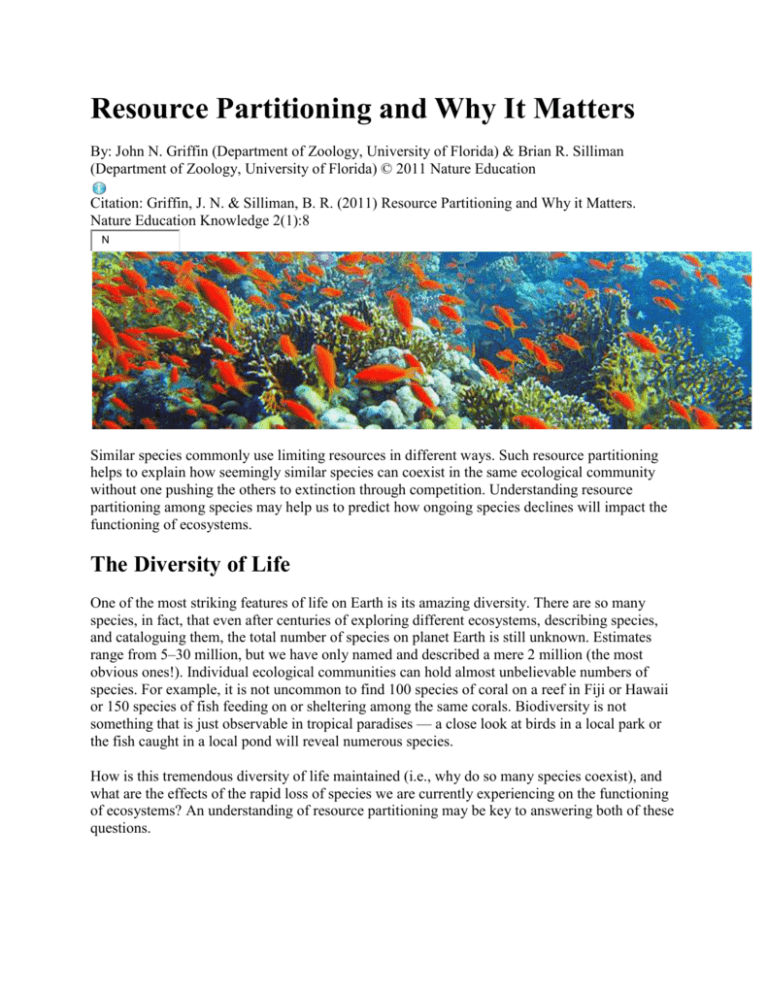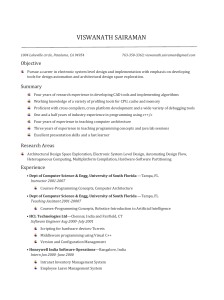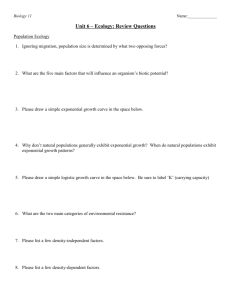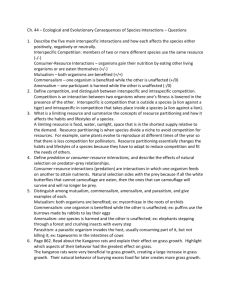
Resource Partitioning and Why It Matters
By: John N. Griffin (Department of Zoology, University of Florida) & Brian R. Silliman
(Department of Zoology, University of Florida) © 2011 Nature Education
Citation: Griffin, J. N. & Silliman, B. R. (2011) Resource Partitioning and Why it Matters.
Nature Education Knowledge 2(1):8
N
Similar species commonly use limiting resources in different ways. Such resource partitioning
helps to explain how seemingly similar species can coexist in the same ecological community
without one pushing the others to extinction through competition. Understanding resource
partitioning among species may help us to predict how ongoing species declines will impact the
functioning of ecosystems.
The Diversity of Life
One of the most striking features of life on Earth is its amazing diversity. There are so many
species, in fact, that even after centuries of exploring different ecosystems, describing species,
and cataloguing them, the total number of species on planet Earth is still unknown. Estimates
range from 5–30 million, but we have only named and described a mere 2 million (the most
obvious ones!). Individual ecological communities can hold almost unbelievable numbers of
species. For example, it is not uncommon to find 100 species of coral on a reef in Fiji or Hawaii
or 150 species of fish feeding on or sheltering among the same corals. Biodiversity is not
something that is just observable in tropical paradises — a close look at birds in a local park or
the fish caught in a local pond will reveal numerous species.
How is this tremendous diversity of life maintained (i.e., why do so many species coexist), and
what are the effects of the rapid loss of species we are currently experiencing on the functioning
of ecosystems? An understanding of resource partitioning may be key to answering both of these
questions.
Similar Species Compete for Limiting Resources
There are only a limited number of ways of "making a living" within ecological communities.
For example, on a coral reef, there are hard-skeleton corals that gain food from capturing
planktonic animals in their tentacles and, in exchange for providing a suitable habitat and
nutrients, gain extra sources of energy from sugar-synthesizing symbiotic algae. Within groups
of species that make a living in a similar way, species compete for the same resources. These
resources, which include nutrients and habitat, are the raw materials needed by organisms to
grow, live, and reproduce. However, resources are not unlimited, and individuals from different
species commonly compete for resources (interspecific competition).
Complete Competitors Cannot Coexist
Classic experiments and mathematical models show that two species cannot coexist on the same
limiting resource if they use it in the same way: The superior competitor will always win out. If
ecologically similar species (like corals on a reef or plants in a field) compete with one another
for limiting resources, what stops the best competitor from out-competing all the others? The
answer may lie in species "doing their own thing" — specializing in their use of resources and
thereby limiting their competition with others.
Dividing the Resource Pie
Species can divide up a limiting resource, such as food, water, or habitat (in other words the
resource "pie"), by using different slices or even using the same "slice" but in different places
(i.e., they are dining in different restaurants, to take the analogy one step further) or at different
times ("do you have a table free at eight o'clock?").
How Do Potential Competitors Partition Resources in Nature?
Careful and detailed study has revealed some of the many ways in which potential competitors
show differences in patterns of resource use.
Perhaps the most obvious way that species can partition resources is in terms of what they
consume. This is often underpinned by differences in their morphological adaptations that allow
differential resource use. For example, a detailed study of bumblebees in the mountains of
Colorado (Figure 1) neatly shows how different species can be best adapted to specific forms of
a resource (Pyke 1982). Bumblebee species all compete for nectar from flowers, but crucially
these flowers vary in the length of their corolla. Matching this variation, different bumblebees in
this area appear to be adapted to specific species of plant that have different corolla lengths in
their flowers. Careful observations of bumblebee visits to different flowers revealed clear
resource partitioning — different species preferred different length corollas in accordance with
their proboscis length (i.e., long proboscis, long corolla; short proboscis, short corolla).
Ecologists have found it relatively easy to document the various differences in the ways that
ecologically similar animal species use their environment and resources. In many cases nothing
more than a pair of binoculars and careful observation is required. Studying resource partitioning
in plants can be much more challenging, and the relative lack of such examples has led many
ecologists to wonder whether plants really do show resource partitioning; after all, they all
require a limited suite of resources (light, water, and nutrients). However, ecologists do not give
up easily, and recent work has shown that coexisting plant species often differ in the forms of
nitrogen (e.g., ammonium versus nitrate or organic v. inorganic) they prefer (Kahmen et al.
2006). Differences in rooting depth and light-use optima have also been documented.
Nevertheless, how common or important resource partitioning is in plants remains uncertain and
is an active area of current research.
/scitable
uninitedaudio
Figure 1: Resource partitioning among bumble bees (Bombus spp.)
Species have proboscises of different lengths, enabling them to specialize in the exploitation of
plants with different length corollas. Species with similar length proboscises occur at different
altitudes (Pyke 1982).
© 2011 Nature Education Adapted from Begon et al. (1990). All rights reserved.
Same Slice, Different Restaurant
When species use a resource similarly in one respect (i.e., they show "overlap" in their use of a
resource along one axis), they commonly show differences in some other respect (along another
axis). For example, the bumblebee study mentioned above was conducted over sites varying in
altitude. Pyke (1982), the author of this work, found that although several bumblebee species had
similarly long proboscises and so could forage on similar species of plant, they were
differentially specialized to altitude, so that sites at different altitudes were dominated by a
different pair of long- and short-length proboscis species. Another striking example comes from
tree-dwelling Anolis lizards on the Caribbean island of Bimini (Schoener 1974; Figure 2). In this
case, species either foraged in the same places (as determined by the thickness of branches they
perched on) or ate similar sized prey, but in no cases did two species do both of these. In
contrast, individuals of the same species commonly showed a high degree of overlap along both
of these resource axes (Figure 2).
/scitable
uninitedaudio
Figure 2: Similarity in structural habitat and prey size in pairs of individual Anolis lizards from
the Caribbean island of Bimini
Pairs of classes that do not belong to the same species (interspecific) do not show high overlap
along both axes (i.e., there are no interspecific pairs in the dashed box).
© 2011 Nature Education Adapted from Schoener (1974). All rights reserved.
Is Resource Partitioning a Solution for Coexistence?
Ecological theory shows that interspecific competition will be less likely to result in competitive
exclusion if it is weaker than intraspecific competition (Chesson 2000). Resource partitioning
can result in exactly this! By consuming slightly different forms of a limiting resource or using
the same limiting resource at a different place or time, individuals of different species compete
less with one another (interspecific competition) than individuals of the same species
(intraspecific competition). Species, therefore, limit their own population growth more than they
limit that of potential competitors, and resource partitioning acts to promote the long-term
coexistence of competing species. Other theories have been put forward that attempt to explain
the coexistence of large numbers of species in local communities, and assessing their importance
relative to resource partitioning is likely to be an active area of research for years to come. There
is no doubt, however, that mechanisms reducing interspecific relative to intraspecific
competition act to promote coexistence, and resource partitioning can achieve this.
Competition Can Drive the Evolution of Differences
So far we have discussed the phenomenon of resource partitioning and its role in reducing
interspecific competition and therefore promoting coexistence. Where does resource partitioning
come from in the first place (i.e., what causes species to be able to partition resources)?
Competition can limit the growth, and ultimately the reproductive success, of individuals. It can
consequently serve as a selection pressure driving differential reproductive success and the
evolution of traits that enable organisms to use resources differently compared to their
competitors. This process has been clearly demonstrated in the evolutionary events that have
followed the colonization of volcanic islands. For example, a single species of seed-eating finch
originally colonized the Galapagos Islands and was faced with a diverse range of seed types and
sizes. However, the beak of the founding species only allowed it to eat a small subset of the
available seed types and sizes. The advantages gained by individuals that were able to exploit
slightly different seed types drove evolution of many new species, each with different shaped
beaks enabling them to specialize in a particular size of seed (Grant 1986).
There is convincing evidence that competition (and not another selection pressure such as
predation) drove — and maintains — differences in beak sizes between these species. When
species occur on their own on an island (i.e., there is no interspecific competition), they have
similarly sized beaks and presumably exploit similarly sized seeds. When several species occur
on the same island however, they show clear differences in beak shapes, showing that it is
interspecific competition that maintains differences between species and resultant resource
partitioning (Figure 3).
An interesting new twist has been added to this story of the evolution of resource partitioning.
Around 25 years ago the island of Daphne Major, originally host to just a single species of
Darwin's finch (Geospiza fortis) was invaded by another, larger beaked species (G.
magnirostris). Amazingly, researchers have documented a rapid evolutionary shift in the sizes of
beaks in G. fortis. In response to severe competition for larger seeds it has evolved to take full
advantage of small seeds. This study is particularly important because the researchers were able
to document the process of character displacement, and by monitoring the levels of resources,
show that competition was the most likely possible cause (Grant & Grant 2006).
/scitable
uninitedaudio
Figure 3: A classic example of character displacement
When multiple species of Darwin's finches co-occur on an island, they show differences in bill
depth (and eat different sized seeds) compared to when they are alone on an island.
© 2011 Nature Education Adapted from Morin (1999). All rights reserved.
Resource Partitioning, Species Extinction, and the
Functioning of Ecosystems
Humans are causing widespread extinctions of species on local and even global scales. Recently,
ecologists have realized that resource partitioning may have important implications for our
understanding of the effects of losing species on the functioning of entire ecosystems.
Groups of ecologically similar species may all contribute toward the same, aggregate ecological
processes; for example, grasses in a meadow all contribute towards overall primary production
and predatory spiders in the same meadow may all contribute towards the control of plant
herbivores. Maintenance of such ecological processes is important for the overall functioning of
ecosystems, including ecosystem services that humans benefit from.
Resource partitioning can help scientists understand how aggregate ecological processes will be
impacted by species extinction. If species show a high degree of resource partitioning, when a
species is lost so too is the capacity of the ecological group to exploit the particular slice of the
resource pie that the deleted species was adapted to exploit. For example, extinction of a species
of grass that was uniquely specialized to use ammonium as a source of nitrogen would leave
ammonium in the soil unused. Because this slice (ammonium) of the resource pie will not be
exploited, the overall rate of new growth of meadow grass (primary production), as well as
associated processes like uptake of carbon dioxide and production of oxygen, will be reduced.
A vast number of recent experiments show that species extinction, on average, reduces levels of
ecosystem processes (Cardinale et al. 2006). Resource partitioning is thought to play an
important role in causing this effect, although ecologists are only just beginning to directly test
this (Griffin et al. 2008, Finke & Snyder 2008). There is an important application of this ongoing
work — by considering the degree of resource partitioning among species scientists may be able
to predict those ecosystems that are most vulnerable to the loss of species.
Summary
The long-term coexistence of ecologically similar species, and thus the astounding diversity of
life on Earth, has long fascinated ecologists. Resource partitioning may hold the answer to the
coexistence of species that make a living in similar ways (i.e., species are able to "stay out of the
way of each other" and reduce interspecific competition by using resources differently). Indeed,
the benefit of tapping into resources that another competing species cannot use as effectively can
be so great that following the addition of a competitor, new traits can literally evolve right in
front of the eyes of scientists!
The astounding diversity of species on Earth is at least partly attributable to the various ways in
which potentially competing species have evolved specialized traits and intricately partitioned
resource exploitation. Ecologists are beginning to realize that the very resource partitioning that
helps maintain species diversity may also leave the overall functioning of ecosystems highly
sensitive to species extinction.
References and Recommended Reading
Chesson, P. Mechanisms of maintenance of species diversity. Annual Review of Ecology,
Evolution and Systematics 31, 343–366 (2000).
Finke, D. L. & Snyder, W. E. Niche partitioning increases resource exploitation by diverse
communities. Science 321: 1488–1490 (2008).
Grant, P. R. Ecology and Evolution of Darwin's Finches. Princeton, NJ: Princeton University
Press, 1986.
Grant, P. R. & Grant, B. Evolution of character displacement in Darwin's finches. Science313,
224–226 (2006).
Griffin, J. N. et al. Predator diversity and ecosystem functioning: density modifies the effect of
resource partitioning. Ecology 89, 298–305 (2008)
Kahmen A. et al. Niche complementarity for nitrogen use — An explanation for the biodiversity
and ecosystem functioning relationship in grasslands? Ecology 87, 1244–1255. (2006)
Pyke, G. H. Local geographic distributions of bumblebees near Crested Butte, Colorado:
competition and community structure. Ecology 63, 555–573 (1982).
Schoener, T.W. Resource partitioning in ecological communities. Science 185, 27–39 1974.









